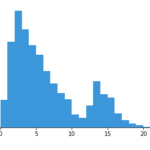This paper was inspired from The Erdős–Szekeres Theorem
Erdos-Szekeres Theorem (in a limited form):
Any sequence of distinct real numbers with the length NxN+1 contains a monotonically increasing subsequence of length N+1 or a monotonically decreasing subsequence of length N+1
Example
any sequence of 10 distinct integers (N=3) contains either ascending or descending subsequence of length at least 4.
With Python loop
for _ in range(10):
v=random.randint(1,100)
print v
i generated 10 random distinct integer from the range [1..100]:
62,55,13,26,83,74,50,6,58,100
the ascending subsequence of length 4 is 13,26,50,58
Application:
Let’s suppose you take a sample of size NxN+1 (e.g. people) and measure two parameters X and Y (e.g. height and IQ). Let’s suppose that all Xs are distinct and all Ys are also distinct.
Let’s sort our sample of NxN+1 elements in ascendig order by X (remind all Xs are different).
Then there exists a subsequence of length N+1 (or the sequence of indices {i1,i2,…,iN+1) such that
either
X_i1 < X_i2 < …< X_iN+1
Y_i1 < Y_i2 < …< Y_iN+1
or
X_i1 < X_i2 < …< X_iN+1
Y_i1 > Y_i2 > …> Y_iN+1

23+ years’ programming and theoretical experience in the computer science fields such as video compression, media streaming and artificial intelligence (co-author of several papers and patents).
the author is looking for new job, my resume







Outstanding post, I think blog owners should learn a lot from this website its rattling user friendly.
I got what you mean , regards for putting up.Woh I am thankful to find this website through google.
As soon as I found this internet site I went on reddit to share some of the love with them.
Can I just say what a relief to find someone who actually knows what theyre talking about on the internet. You definitely know how to bring an issue to light and make it important. More people need to read this and understand this side of the story. I cant believe youre not more popular because you definitely have the gift.
I am not really fantastic with English but I line up this very easy to read .
I really happy to find this website on bing, just what I was looking for : D besides saved to favorites.
This design is incredible! You definitely know how to keep a reader entertained. Between your wit and your videos, I was almost moved to start my own blog (well, almost…HaHa!) Excellent job. I really loved what you had to say, and more than that, how you presented it. Too cool!
You have brought up a very good points, thanks for the post.
An interesting discussion is worth comment. I think that you should write more on this topic, it might not be a taboo subject but generally people are not enough to speak on such topics. To the next. Cheers
I was just seeking this information for some time. After 6 hours of continuous Googleing, finally I got it in your site. I wonder what’s the lack of Google strategy that don’t rank this kind of informative web sites in top of the list. Generally the top websites are full of garbage.
I conceive you have remarked some very interesting details, appreciate it for the post.
I absolutely love your blog and find nearly all of your post’s to be just what I’m looking for. Does one offer guest writers to write content for yourself? I wouldn’t mind producing a post or elaborating on most of the subjects you write about here. Again, awesome site!
Experts are reluctant to share their knowledge and experience pro bono.